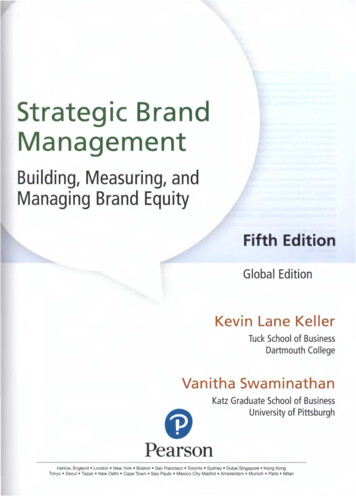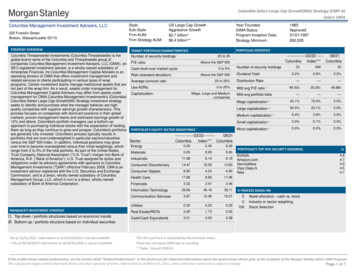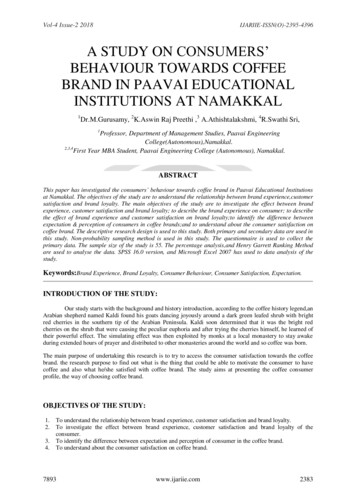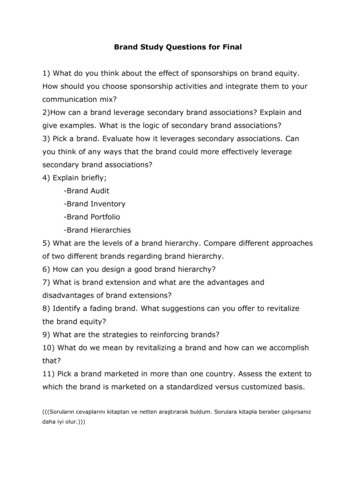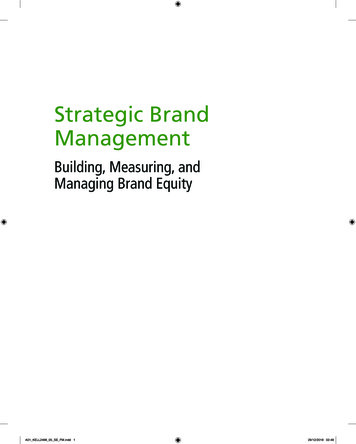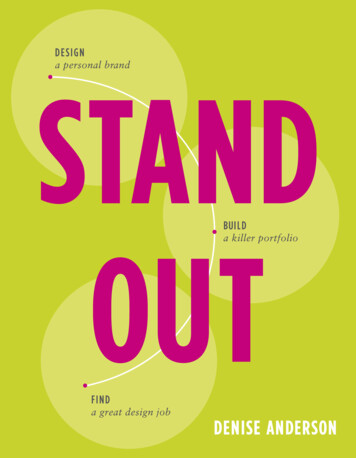
Transcription
J. Jo s̆ko Brakus, Bernd H. Schmitt, & Lia ZarantonelloBrand Experience: What Is It? How IsIt Measured? Does It Affect Loyalty?Brand experience is conceptualized as sensations, feelings, cognitions, and behavioral responses evoked bybrand-related stimuli that are part of a brand’s design and identity, packaging, communications, and environments.The authors distinguish several experience dimensions and construct a brand experience scale that includes fourdimensions: sensory, affective, intellectual, and behavioral. In six studies, the authors show that the scale is reliable,valid, and distinct from other brand measures, including brand evaluations, brand involvement, brand attachment,customer delight, and brand personality. Moreover, brand experience affects consumer satisfaction and loyaltydirectly and indirectly through brand personality associations.Keywords: experience marketing, brand experience, customer experience management, scale development,marketing communicationsbrand attachment) and develop a scale that can measure thestrength with which a brand evokes each experience dimension. However, the experience construct is not as clearlyassociated with one particular basic discipline (e.g., psychology) as other brand constructs are. For example, brandpersonality and brand attachment have been defined on thebasis of equivalent concepts in personality and developmental psychology; as a result, the development ofscale items was relatively straightforward. In contrast, writing on experience can be found in a wide range of fields,including marketing, philosophy, cognitive science, andmanagement practice. Therefore, we must clearly conceptualize our construct and develop scale items based on thisconceptualization.To define and conceptualize the brand experience construct, we begin with a review of consumer and marketingresearch, which examines when experiences occur and howthey affect judgments, attitudes, and other aspects of consumer behavior. Next, we review the literature in philosophy, cognitive science, and applied management to distinguish brand experience dimensions and develop a brandexperience scale. We then examine the psychometric properties of the scale using standard scale validation procedures. Finally, we test whether brand experience affectsconsumer satisfaction and loyalty.ow do consumers experience a brand? How is brandexperience measured? Does brand experience affectconsumer behavior? Many useful constructs andmeasurements have been developed recently in the brandingliterature, including brand personality, brand community,brand trust, brand attachment, and brand love (Aaker 1997;Carroll and Ahuvia 2006; Delgado-Ballester, MunueraAlemán, and Yagüe-Guillén 2003; McAlexander, Schouten,and Koenig 2002; Thomson, MacInnis, and Park 2005).However, a conceptualization and scale for measuringbrand experiences has not yet been developed. In addition,research has studied contexts in which specific product andservice experiences arise (Arnould, Price, and Zinkhan2002). However, research has largely ignored the exactnature and dimensional structure of brand experiences.Notably, brand experience has attracted a lot of attention in marketing practice. Marketing practitioners havecome to realize that understanding how consumers experience brands is critical for developing marketing strategiesfor goods and services. Many trade writings have appearedthat present useful concepts as well as some ad hoc experience measurements (Chattopadhyay and Laborie 2005; Pineand Gilmore 1999; Schmitt 1999, 2003; Shaw and Ivens2002; Smith and Wheeler 2002).In this article, we present both a conceptual analysis ofbrand experience and a brand experience scale. As withother brand research, the development of a brand experience scale must go hand-in-hand with conceptual development of the construct itself. We need to identify the underlying dimensions of brand experience (analogous to the“Big Five” dimensions of brand personality or the dimensions of affection, connection, and passion that make upHThe Experience Concept inConsumer and Marketing ResearchConsumer and marketing research has shown that experiences occur when consumers search for products, whenthey shop for them and receive service, and when they consume them (Arnould, Price, and Zinkhan 2002; Brakus,Schmitt, and Zhang 2008; Holbrook 2000). We discuss eachin turn.J. Jos̆ko Brakus is Assistant Professor of Marketing, William E. SimonGraduate School of Business Administration, University of Rochester(e-mail: brakus@simon.rochester.edu). Bernd H. Schmitt is Robert D.Calkins Professor of International Business, Columbia Business School,Columbia University (e-mail: bhs1@columbia.edu). Lia Zarantonello is apostdoctoral research fellow, Department of Management, Institute ofMarketing, Bocconi University (e-mail: lia.zarantonello@unibocconi.it).The authors contributed equally to the article and are listed in alphabetical order. They thank Professor Kamel Jedidi for his help in data analyses. 2009, American Marketing AssociationISSN: 0022-2429 (print), 1547-7185 (electronic)Product ExperienceProduct experiences occur when consumers interact withproducts—for example, when consumers search for products and examine and evaluate them (Hoch 2002). Theproduct experience can be direct when there is physical52Journal of MarketingVol. 73 (May 2009), 52–68Reprinted with permission from the Journal of Marketing, published by the American Marketing Association,Bernd Schmitt, Josko Brakus, and Lia Zarantonello, Vol. 73, 2009, pp. 52-68.
contact with the product (Hoch and Ha 1986) or indirectwhen a product is presented virtually or in an advertisement(Hoch and Ha 1986; Kempf and Smith 1998). Respondentsare typically asked to reflect on a combination of direct andindirect product experiences to investigate how the combination affects product judgments, attitudes, preferences,purchase intent, and recall (Hoch and Deighton 1989; Hochand Ha 1986; Huffman and Houston 1993).Shopping and Service ExperienceShopping and service experiences occur when a consumerinteracts with a store’s physical environment, its personnel,and its policies and practices (Hui and Bateson 1991; Kerin,Jain, and Howard 2002). Thus, research in this area investigates how atmospheric variables and salespeople affect theexperience (Arnold et al. 2005; Boulding et al. 1993; Jones1999; Ofir and Simonson 2007). Several articles have investigated customers’ interaction with salespeople and how thatexperience affects customers’ feelings, brand attitudes, andsatisfaction (Grace and O’Cass 2004).Consumption ExperienceExperiences also occur when consumers consume and useproducts. Consumption experiences are multidimensionaland include hedonic dimensions, such as feelings, fantasies,and fun (Holbrook and Hirschman 1982). Much of theinterpretive research on consumption experiences has analyzed hedonic goals that occur during and after the consumption of, for example, museums, river rafting, baseball,and skydiving (Arnould and Price 1993; Celsi, Rose, andLeigh 1993; Holt 1995; Joy and Sherry 2003).In summary, experiences arise in a variety of settings.Most experiences occur directly when consumers shop, buy,and consume products. Experiences can also occur indirectly—for example, when consumers are exposed to advertising and marketing communications, including Web sites.Conceptualizing Brand ExperienceMost of the research on experiences to date has focused onutilitarian product attributes and category experiences, noton experiences provided by brands. When consumerssearch for, shop for, and consume brands, they are exposedto utilitarian product attributes. However, they are alsoexposed to various specific brand-related stimuli, such asbrand-identifying colors (Bellizzi and Hite 1992; Gorn et al.1997; Meyers-Levy and Peracchio 1995), shapes (Veryzerand Hutchinson 1998), typefaces, background design elements (Mandel and Johnson 2002), slogans, mascots, andbrand characters (Keller 1987). These brand-related stimuliappear as part of a brand’s design and identity (e.g., name,logo, signage), packaging, and marketing communications(e.g., advertisements, brochures, Web sites) and in environments in which the brand is marketed or sold (e.g., stores,events). These brand-related stimuli constitute the majorsource of subjective, internal consumer responses, whichwe refer to as “brand experience.”Thus, we conceptualize brand experience as subjective,internal consumer responses (sensations, feelings, and cognitions) and behavioral responses evoked by brand-relatedstimuli that are part of a brand’s design and identity, packaging, communications, and environments. In the followingsections, we explicate the brand experience construct further and differentiate it from other brand concepts. Mostimportant, we distinguish various dimensions of brandexperience.Further Explication of the Brand ExperienceConstructBrand experiences vary in strength and intensity; that is,some brand experiences are stronger or more intense thanothers. As with product experiences, brand experiences alsovary in valence; that is, some are more positive than others,and some experiences may even be negative. Moreover,some brand experiences occur spontaneously without muchreflection and are short-lived; others occur more deliberately and last longer. Over time, these long-lasting brandexperiences, stored in consumer memory, should affectconsumer satisfaction and loyalty (Oliver 1997; Reicheld1996).Differences Between Brand Experience and OtherBrand ConstructsBrand experience is related but also conceptually distinctfrom other brand constructs. In particular, brand experiencediffers from evaluative, affective, and associative constructs,such as brand attitudes, brand involvement, brand attachment, customer delight, and brand personality.Attitudes are general evaluations based on beliefs orautomatic affective reactions (Fishbein and Ajzen 1975;Murphy and Zajonc 1993). In contrast, brand experiencesare not general evaluative judgments about the brand (e.g.,“I like the brand”). They include specific sensations, feelings, cognitions, and behavioral responses triggered by specific brand-related stimuli. For example, experiences mayinclude specific feelings, not just an overall “liking.” Attimes, experiences may result in general evaluations andattitudes, especially evaluations of the experience itself(e.g., “I like the experience”). However, the overall attitudetoward the experience captures only a small part of theentire brand experience.Brand experience also differs from motivational andaffective concepts, such as involvement (Zaichkowsky1985), brand attachment (Thomson, MacInnis, and Park2005), and customer delight (Oliver, Rust, and Varki 1997).Involvement is based on needs, values, and interests thatmotivate a consumer toward an object (e.g., a brand).Antecedents of involvement include the perceived importance and personal relevance of a brand (Zaichkowsky1985). Brand experience does not presume a motivationalstate. Experiences can happen when consumers do not showinterest in or have a personal connection with the brand.Moreover, brands that consumers are highly involved withare not necessarily brands that evoke the strongestexperiences.If involvement can be characterized by mild affect,brand attachment refers to a strong emotional bond (i.e.,“hot affect”) between a consumer and a brand, as evidencedby its three dimensions—affection, passion, and connectionBrand Experience / 53
(Park and MacInnis 2006; Thomson, MacInnis, and Park2005). In contrast to brand attachment, brand experience isnot an emotional relationship concept. As we described previously, experiences are sensations, feelings, cognitions,and behavioral responses evoked by brand-related stimuli.Over time, brand experiences may result in emotionalbonds, but emotions are only one internal outcome of thestimulation that evokes experiences.As with brand attachment, customer delight is characterized by arousal and positive affect; it can be consideredthe affective component of satisfaction (Oliver, Rust, andVarki 1997). Customer delight results from disconfirming,surprising consumption (Oliver, Rust, and Varki 1997). Incontrast to customer delight, brand experiences do notoccur only after consumption; they occur whenever there isa direct or indirect interaction with the brand. Moreover, abrand experience does not need to be surprising; it can beboth expected or unexpected.Finally, brand experience is distinct from brand associations and brand image (Keller 1993). One of the most studied constructs of brand associations is brand personality(Aaker 1997). Consumers tend to endow brands withhuman characteristics that result in a brand personality,which consists of five dimensions—sincerity, excitement,competence, sophistication, and ruggedness (Aaker 1997).Brand personality is based on inferential processes (Johar,Sengupta, and Aaker 2005). That is, consumers are not sincere or excited about the brand; they merely project thesetraits onto brands. In contrast, brand experiences are actualsensations, feelings, cognitions, and behavioral responses.Thus, because brand experience differs from brand evaluations, involvement, attachment, and customer delight, brandexperience is also conceptually and empirically distinctfrom brand personality.Dimensions of Brand ExperienceTo identify dimensions of brand experience, we next reviewpertinent work in philosophy, cognitive science, and appliedwritings on experiential marketing and management. In thisliterature, across a variety of disciplines, a fairly consistentset of experience dimensions, which are highly relevant tobrands, has been proposed.Philosophical InvestigationsThe philosopher John Dewey (1922, 1925) views experience as the intertwining of human beings and their environments. He critiques the purely cognitive Kantian view ofexperience as knowledge, arguing that knowledge (classifying, analyzing, and reasoning about things) is only one partof a person’s understanding of the world. In addition tointellectual experiences resulting from knowledge, experiences also include perceiving (through the senses), feeling,and doing. Moreover, human beings are fundamentally connected with other people. Following Dewey, Dubé andLeBel (2003) distinguish four “pleasure dimensions”: intellectual, emotional, social, and physical pleasures.54 / Journal of Marketing, May 2009Cognitive ScienceCognitive scientists have investigated “mental modules,” orspecial purpose computational systems that respond to specific environmental cues and solve a restricted class ofproblems (Fodor 1998). Pinker (1997) identifies four mental modules that correspond closely to the experiences thatDewey (1922, 1925) postulates: sensory perception, feelings and emotions, creativity and reasoning, and social relationships. However, Pinker does not list a separate “doing”module; he considers bodily experiences and motor actionsand behaviors part of the “sensory-motor module,” similarto Lakoff and Johnson’s (1999) concept of embodiedcognition.Applied Writings on Experience Marketing andManagementPine and Gilmore (1999) study “staged experiences” inretail environments and events. For these settings, theydistinguish aesthetic (including visual, aural, olfactory, andtactile aspects), educational, entertaining, and escapistexperiences. Although Pine and Gilmore’s framework islimited to retail settings and events, their four experiencedimensions nonetheless overlap with some of the dimensions of experience we discussed previously, thus confirming the need for conceptualizing a sensory/aesthetic, intellectual/educational, and emotional/entertaining dimension.Schmitt (1999) proposes five experiences: sense, feel,think, act, and relate. The sense experience includes aesthetics and sensory qualities. Consistent with recent research inconsumer behavior (Richins 1997), the feel experienceincludes moods and emotions. The think experienceincludes convergent/analytical and divergent/imaginativethinking. The act experience refers to motor actions andbehavioral experiences. Finally, the relate experience refersto social experiences, such as relating to a reference group.The five experiences are closely related to Dewey’s (1922,1925) categorization, Dubé and LeBel’s (2003) pleasureconstruct, and Pinker’s (1997) mental modules, especially ifwe view Pinker’s sensory module as including sensory andbehavioral components.SummaryThere has been considerable agreement in the categorization of experiences by philosophers, cognitive scientists,and management thinkers. Therefore, for the scale development that follows, it is necessary to generate items along thefive experience dimensions that broadly emerged from ourliterature review: sensory, affective, intellectual, behavioral,and social.In line with our conceptualization, the experiencedimensions are evoked by brand-related stimuli (e.g., colors, shapes, typefaces, designs, slogans, mascots, brandcharacters). Note that there is no one-to-one correspondence, such that a certain stimulus type would trigger a certain experience dimension and only that dimension. Forexample, although colors, shapes, typefaces, and designsusually result in sensory experience, they may also result inemotions (e.g., red for Coca-Cola) or intellectual experiences (e.g., when designs use complex patterns). Similarly,
although slogans, mascots, and brand characters may resultin imaginative thoughts, they may also trigger emotions(e.g., “Bibendum,” the Michelin Man) or stimulate actions(e.g., Nike’s “Just Do It”). In addition, when consumerscomplete brand experience scales, such scales are usuallynot directly assessing the dynamic, “online” experience ofthe consumer in the here and now; rather, such scales typically assess a lasting trace stored in long-term memorybased on multiple exposures to brand-related stimuli.Before we develop the actual scale, we first report theresults of an exploratory, qualitative study that we designedto determine whether the conceptualization of brand experience presented here was in line with consumers’ conceptions of brand experience.Consumers’ Conceptions of BrandExperienceAre consumers’ conceptions of experience similar to ourconceptualization? To address this question, we askedgraduate-level business students (N 25) to describe theirexperience with a brand of their choice. We instructed participants to choose a brand that provides a strong experiencefor them, to list the brand, and then to describe their experience in an open-ended way on one sheet of paper. Next, weasked them to choose a brand in the same or a related category that provides a weak experience for them or no experience at all and to describe in an open-ended way the “sensations, feelings, thoughts, and behaviors that they mighthave or engage in, alone or with others.” Note that, giventhe instructions, participants needed to rely on their ownconceptions of experience for the experiential brand, butthey were primed with terms related to experience dimensions for the weak experiential brand. This allowed for aconservative assessment of whether consumers shared ourconception of experience and whether they perceived a difference between strong experiential and weak experientialbrands.Participants in the study provided open-ended responsesfor a variety of goods and service brands. They rated thefollowing brands to be strong experiential brands: Abercrombie & Fitch, American Express, Apple/iPod (chosen bysix respondents), The Body Shop, BMW, Crest, Disney,Google, HBO, Home Depot, MasterCard, Nike (chosen byfour respondents), Starbucks, Target, W Hotel, WashingtonMutual, and Williams-Sonoma. Participants provideddescriptions of weak experiential brands for Aéropostale,Canon, Dell, Dick’s Sporting Goods, Douglas, Dunkin’Donuts, Hilton, Macy’s, Microsoft, Reebok (chosen by tworespondents), Sony, Sur La Table, Tim Hortons, True Value,Visa (chosen by two respondents), Volkswagen, and WalMart. Some respondents defined “category” more broadlythan others (e.g., consumer electronics rather than MP3players). Six respondents did not provide a specific weakexperiential brand in the same category but described weakexperiential brands in the category generically. Althoughthese respondents did not strictly follow instructions, weincluded their responses to avoid biasing the results.A content analysis of the open-ended responses indicated that all consumers had a concept of brand experience.Respondents reported brand experiences that occurredwhen they shopped and consumed brands. They alsoviewed brand experiences as being evoked by brand-relatedstimuli. For each experiential brand, we asked two raters toselect descriptions that corresponded with our conceptualization of sensory, affective, cognitive, behavioral, andsocial experiences. As an illustration, in Table 1, we presentthree descriptions per strong experiential brand, which hadbeen selected by both raters. (For Apple and Nike, whichhad been selected as strong experiential brands by morethan one respondent, we provide six descriptions each.) AsTable 1 shows, participants provided descriptions of sensations (e.g., “touch and feel,” “appeal to different senses,”“smells nice and is visually warm”), a wide range of feelings (e.g., “fun,” “refreshed,” “inspired,” “nostalgia”), analytical and imaginative thoughts (e.g., “the brand intriguesme,” “I think of topics like animal testing, purity and wellness,” “reminds me to use my imagination”), and behaviors(e.g., “I change the way I organize and interact with information,” “I want to work out,” “It’s a place I want to go”).Participants also made occasional references to the socialcontext of branded experiences (e.g., “It’s like a membership in an exclusive, country-clubish community,” “I ampart of a ‘smarter’ community,” “I feel like an athlete”). Wealso analyzed the descriptions for the weak experientialbrands. In contrast to the strong experiential brands, participants described weak experiential brands mostly in terms ofprice and promotions, as well as functionality and basics,even though they were explicitly primed with an experiential terminology. For example, consider the followingdescriptions of Wal-Mart, Visa, and Aéropostale: “Theyfocus on price as low as price can be; their retail stores areincredibly basic” (for Wal-Mart); “Visa is not about experience. Visa promotes being accepted everywhere. Visa isabout convenience and reliability and less about how I as acustomer feel about the brand”; “Aéro’s brand stands for little more than cheap clothing” (for Aéropostale).Two other findings are noteworthy. First, almost alldescriptions of strong experiential brands were positive;only 2 of the 25 respondents provided some negativedescriptions (see Table 1). Moreover, many descriptionswere at the general level of experiences at which we provided our conceptualization. Only 6 respondents provideddetailed descriptions of highly specific elements of theirexperiences—for example, by referring to the colors anddesign of Apple products, the background music or visualdesign in stores, or the way a BMW drives (“I love the sensations I get from BMW: The noise of the motor duringacceleration; the grip on curves, the resistance on the steering wheel when I turn”). In summary, the qualitative studyshows that consumers’ conceptions of brand experience arealigned with the concept of brand experience we developedfrom prior research and theoretical writings in variousdisciplines.Developing the Brand ExperienceScaleNext, we develop a brand experience scale that captures thedimensions of brand experience and the level of experienceBrand Experience / 55
TABLE 1Descriptions of Experiential BrandsAbercrombie & Fitch It’s a complete experience when you enter the store. Stimulates me; sexy. It’s like a membership in an exclusive, country-clubishcommunity.American Express It’s an interactive experience. Part of luxury, sophistication, and exclusivity. Because of sponsoring activities, I feel fun, excitement,and entertainment.Apple/iPod I love the touch and feel of the products. I enjoy playing with all the products. I am part of a “smarter” community. This brand intrigues me. I really feel Apple products go with my way of life. I use the iPod when I am jogging, and I exercise morebecause of the iPod.The Body Shop Appeals to different senses. I think of topics like animal testing, purity, and wellness. I want to be with people that share the values that thebrand promotes.BMW I feel young; I feel stylish. It’s just great to drive. A BMW is the symbol of my success.Crest I feel refreshed. Don’t really like the smell. Feels clean, fresh, and healthy.Disney Stimulates my senses. I feel like a child; I feel warm and safe; I want to discoverthings; the brand reminds me to use my imagination. I feel part of the magic.Google The search is elegant; it creates a mood of playfulnessand curiosity. I feel happy and proud because I am “smart” and “in-theknow.” With Google, I change the way I organize and interactwith information.HBO Puts me in a good mood. It’s “discussion inducing”; I want to discuss the showswith others. I enjoy the entertainment.evoked by the brand on each dimension. As part of the scaledevelopment, we must address methodological challenges.First, in contrast to some other brand scales adopted fromexisting scales in psychology, the development of a brandexperience scale requires a broader search for acceptableitems. Second, the items of the scale should focus on thedegree to which a consumer has a sensory, affective, intellectual, behavioral, or social experience with a brand; theyshould not measure the specific sensory, affective, intellectual, behavioral, or social content of the experience (e.g.,whether the experience is visually exciting or emotionallywarm; what specific imaginary thoughts or behavioralactions come to mind). Several scales already provide56 / Journal of Marketing, May 2009Home Depot I did not know anything about construction, but I feltreally comfortable. I felt confident and in good hands. Provides the experience that any customer can tackleany home improvement project.MasterCard Makes me think about precious things in life. I feel more youthful than using American Express orVisa. Initially the “Priceless” campaign was emotive, but it’snow simply a way of identifying the brand for me.Nike Makes me think of how to live an active lifestyle. Makes me feel powerful. I want to work out. I feel inspired to start working out. I feel like an athlete. The store incites me to act, like swing the baseball bat,or put on the running shoes. I enjoy designing my own shoe that perfectly fits mypersonality.Starbucks Smells nice and is visually warm. It’s comfortable and puts me in a better mood. It’s like being around a Barnes & Nobles crowd.Target Shopping experience is very pleasant. Products are displayed to please the eye. Many stores are putting in Starbucks for an even moreenhanced shopping experience.W Hotel Being part of something fun, happening, and exciting. It was an amazing feeling to hang out in the lobby. Service is disappointing.Washington Mutual I have positive feelings because of their friendliness. It’s a place I want to go and do not have to go. I also had a negative one-time experience.Williams-Sonoma I had a feeling of nostalgia. Full of memories of home. It’s relaxed and unhurried.highly specific measures for specific experiences, such asthe visual product aesthetics scale (Bloch, Brunel, andArnold 2003), emotions scales (Izard 1978), or the needfor-cognition scale (Cacioppo and Petty 1982). These scalesfocus on individual reactions to specific stimuli (e.g., welldesigned products) or tasks (e.g., abstract thinking). Theyuse multifaceted items to measure specific sensations (e.g.,“I enjoy seeing displays of products that have superiordesign”; “When I see a product that has a really greatdesign, I feel a strong urge to buy it”; Bloch, Brunel, andArnold 2003), specific emotions (e.g., “affectionate,”“attached,” “passionate”; Thomson, MacInnis, and Park2005), or specific intellectual processes (e.g., “I would pre-
fer complex to simple problems,” “The notion of thinkingabstractly appeals to me”; Cacioppo and Petty 1982).Although reviewing such scales is important, the specificitems on these scales are of limited value given our objective of measuring more generally whether and to whatdegree a consumer has a sensory, affective, intellectual,behavioral, or social experience.In Study 1, we conduct an extensive literature review,select initial items along the five proposed dimensions, andask experts and consumers to screen these items. In Study2, we ask consumers to rate 21 brands on the remainingitems of Study 1, and we conduct an exploratory factoranalysis to determine the dimensionality of the scale; moreover, we show that the scale has criterion validity. In Study3, using a shorter scale and a new sample of consumers andbrands, we use exploratory and confirmatory factor analyses to further determine the scale dimensionality. In Study4, we examine the dimensionality of the scale with a nonstudent population; in addition, we show that brand experience is distinct from general brand evaluations and that thescale is reliable over time. Finally, in Study 5, we examinethe discriminant validity of the scale from motivational andaffective brand scales, such as brand involvement, brandattachment, and customer delight.naire in random order. After the initial screening and facevalidity check, we retained 125 applicable items: 24 sensory, 29 affective, 26 intellectual, 23 behavioral, and 23social items.Next, 30 university students were paid 5 each to participate in a study on brand experience. We modeledinstructions after the work of Thomson, MacInnis, and Park(2005). After explaining the concept of brand experience,we asked the participants to e
J. Jo sko Brakus is Assistant Professor of Marketing, William E. Simon Graduate School of Business Administration, University of Rochester (e-mail: brakus@simon.rochester.edu). Bernd H. Schmitt is Robert D. Calkins Professor of International Business, Columbia Business School, Columbia University (e-mail: bhs1@columbia.edu). Lia Zarantonello is a
